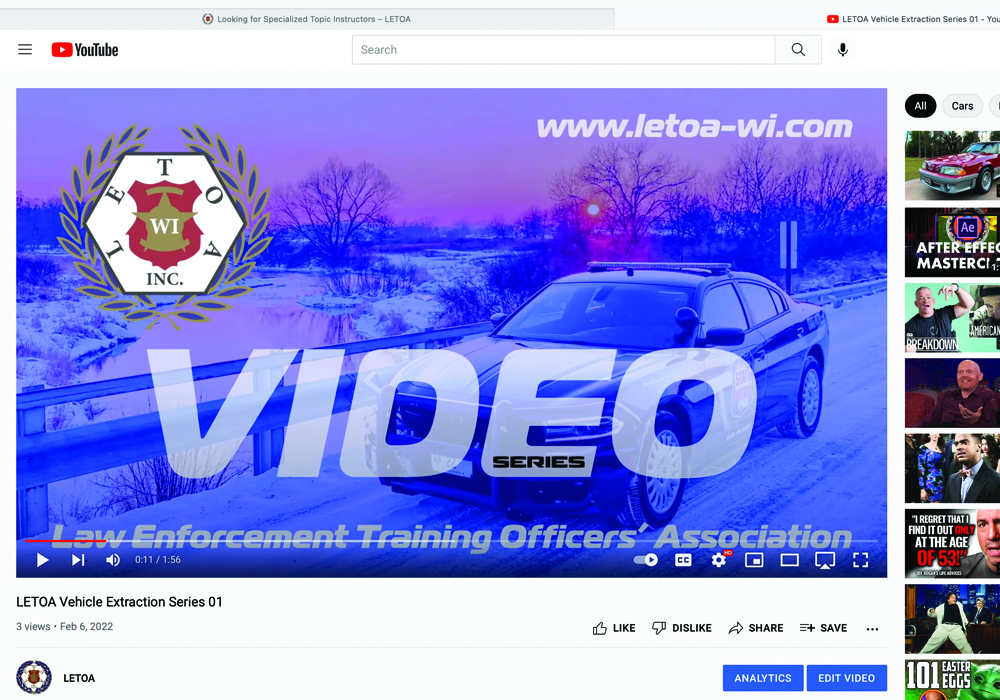LETOA has released a new 10-part video series that focuses on removing a non-compliant, yet non-combative, driver from a vehicle. These videos were originally shot a few years ago at the Appleton Police Department as part of a defensive tactics in-service training. While there are multiple options shown, not all were ultimately approved for use by Command Staff. Specifically, it was decided not to use the option which involved a collapsed baton.
Despite the baton option not being formally adopted in Appleton, LETOA left the technique in the video series. Each department can make its own decisions as to what fits within their approved tactics and policy. Agencies can then adopt what will work and disregard the rest. LETOA members are allowed to use these videos for roll call training, in-services, or as a baseline to develop additional options. While these are options to extract a subject from a vehicle, verify it is in compliance with your state law and department policy before utilizing.
Uploaded Videos
- Initial Contact – This is the first of a ten part series to remove an uncooperative (non-combative) driver from a vehicle. Video first focuses on the initial contact and control to remove keys and seatbelt. Click Here to open in YouTube.
- Thumb Peel – This is the second of a ten part series to remove an uncooperative (non-combative) driver from a vehicle. Video two focuses on removing the left hand from the steering wheel and gaining control of the arm. Click Here to open in YouTube.
- Escort to Armbar – This is the third of a ten part series to remove an uncooperative (non-combative) driver from a vehicle. Video three focuses on the difference with leverage on the elbow vs the shoulder. Click Here to open in YouTube.
- Subject Stands – This is the fourth of a ten part series to remove an uncooperative (non-combative) driver from a vehicle. Video four focuses on transitioning to a door pin when the subject exits the vehicle standing. Click Here to open in YouTube.
- Subject Goes to Ground – This is the fifth of a ten part series to remove an uncooperative (non-combative) driver from a vehicle. Video five focuses on bringing the person safely to the ground if they don’t stand when exiting the vehicle. Click Here to open in YouTube.
- Come-Along Option – This is the sixth of a ten part series to remove an uncooperative (non-combative) driver from a vehicle. Video six shows how to transition to a come-along if subject bends their arm. Click Here to open in YouTube.
- Head First Option – This is the seventh of a ten part series to remove an uncooperative (non-combative) driver from a vehicle. Video seven shows an option to remove a subject head first while supporting the neck. Click Here to open in YouTube.
- Use of Baton – This is the eighth of a ten part series to remove an uncooperative (non-combative) driver from a vehicle. Video eight utilizes a baton for pain compliance. Click Here to open in YouTube.
- Leg Drag Option – This is the ninth of a ten part series to remove an uncooperative (non-combative) driver from a vehicle. Video nine shows how to utilize a leg drag when the subject turns inside the vehicle. Click Here to open in YouTube.
- Ankle/Achilles Option – This is the tenth of a ten part series to remove an uncooperative (non-combative) driver from a vehicle. Video ten focuses on transitioning to pain compliance when a subject frames in the car. Click Here to open in YouTube.
Disclaimer
Any statements made are those of the individual officer and do not necessarily represent the views of their agency, department, educational facility, or community leadership. The information provided by the Law Enforcement Officers’ Training Association on this or its social media outlets are for general information purposes only. All information is provided in good faith. However, we make no representation or warranty of any kind, express or implied, regarding the accuracy, adequacy, validity, availability, completeness, or local legality of information or techniques. Click Here for a complete article disclaimer.


